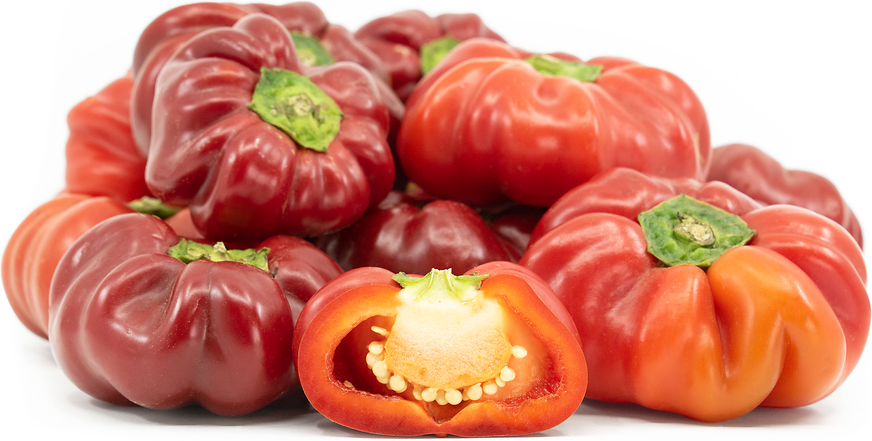


Paprika Pimentos Chile Peppers
Estimated Inventory, lb : 30.66
This item was last sold on : 07/28/25
Description/Taste
Pimento chile peppers are small, somewhat uniform pods, averaging 5 to 7 centimeters in diameter and 7 to 10 centimeters in length, and have a globular to slightly flattened, curved shape. The skin is glossy, smooth, and taut, covered in deep creases and folds around the stem-end. As the pods ripen, they transform from green to bright red and also develop a subtle fruity and floral aroma. Underneath the surface, the thick flesh is crisp, chewy, aqueous, and pale green to red, depending on maturity, encasing a central cavity filled with membranes and a few round and flat, cream-colored seeds. Pimento chile peppers contain no spice and have a rich, sweet, and fruity flavor with subtly earthy, vegetal undertones.
Seasons/Availability
Pimento chile peppers are available in the late summer through early fall.
Current Facts
Pimento chile peppers, botanically classified as Capsicum annuum, are a sweet, heatless variety belonging to the Solanaceae or nightshade family. The fruity, vegetal peppers are also spelled Pimiento in Spain and are sometimes labeled as Cherry peppers in European markets. Pimento chile peppers are very mild and not spicy, ranging 100-500 SHU on the Scoville scale, and are known to have one of the lowest Scoville ratings of any chile pepper. The mild peppers are primarily celebrated for their use in the canning and bottling industry, being one of the most popular pepper varieties used for cheese spreads, sauces, and stuffed olives. Despite their worldwide notoriety as a canned pepper, fresh Pimento chile peppers are challenging to find in commercial markets and are considered to be a specialty variety found through select farmer’s markets.
Nutritional Value
Pimento chile peppers are an excellent source of vitamins A and C, which are antioxidants that can help boost the immune system and repair damage within the body from external aggressors. The peppers also contain some potassium, folate, manganese, and vitamins B6, E, and K.
Applications
Pimento chile peppers are best suited for both raw and cooked applications such as roasting, grilling, and baking. The sweet flavor of the pods can be used as a substitute in any recipe calling for bell peppers, and the peppers can be chopped into salads, sliced and displayed on vegetable platters, baked into bread, or sliced and layered onto sandwiches. Pimento chile peppers can also be stuffed with cheeses, grains, and meats, tossed into soups or stews, or they can be roasted and added to paella, tapas, omelets, dips, sauces, and spreads. In addition to cooked applications, the peppers can be pickled, diced and stuffed into green olives, or dried, ground into a powder, and sold as the spice paprika. Pimento chile peppers pair well with celery, carrots, aromatics such as garlic, onions, and ginger, tomatoes, potatoes, meats such as chorizo, ham, prosciutto, lamb, and fish, shrimp eggs, cheeses such as cheddar, mozzarella, and feta, chickpeas, legumes, rice, and hazelnuts. The fresh peppers will keep 1 to 2 weeks when loosely stored whole and unwashed in a paper or plastic bag in the refrigerator.
Ethnic/Cultural Info
In the United States, Pimento chile peppers are the main ingredient in Pimento cheese, which is a creamy spread used across the country, especially in the Southern United States. Pimento cheese was originally a blend of canned Pimento peppers and cream cheese, created in the early 1900s in New York, and was marketed as an affordable sandwich filling. The thick spread became wildly popular during The Great Depression as an inexpensive but filling item to pair with chips, bread, or crackers, and it was later used to feed troops during World War II. During this time, Pimento chile peppers also began to be locally grown and processed in factories in Georgia, which caused the cheese spread to become accessible throughout the south. With this increased availability of canned peppers, new recipes and variations of the cheese were developed using ingredients such as mayonnaise, cheddar cheese, and vidalia onions, earning Pimento cheese the nickname of the “caviar of the south.” Pimento cheese is still widely used throughout the Southern United States in the modern-day and is frequently seen on plates at family dinners, parties, and picnics.
Geography/History
Pimento chile peppers are native to Central and South America and have been cultivated since ancient times. The peppers were then introduced to Europe in the 15th and 16th centuries via Spanish and Portuguese explorers, where they became increasingly popular, especially in Spain, for their use in the spice, sweet paprika. The peppers were also widely used for commercial canning in Spain, allowing the country to export the peppers around the world. When the canned peppers became a widely used commodity in the United States in the 1900s, farmers in the south began cultivating Pimento chile peppers to provide local sources for the in-demand, commercial variety. Today Pimento chile peppers are highly cultivated in Spain, Hungary, Morocco, and the Middle East and are primarily used for processing. The peppers are also grown for fresh use through specialty farms and in home gardens throughout the United States and Europe.
Featured Restaurants
Restaurants currently purchasing this product as an ingredient for their menu.
| Nomad Donuts | San Diego CA | 619-431-5000 |
| Lodge at Torrey Pines Main | San Diego CA | 858-453-4420 |
| The Pearl Hotel | San Diego CA | 877-732-7573 |
| Ctzn | Solana Beach CA | 858-925-7141 |
| Sovereign Thai Cuisine | San Diego CA | 619-887-2000 |
| Relic Bageri LLC | San Diego CA | 619-335-6328 |
Recipe Ideas
Recipes that include Paprika Pimentos Chile Peppers. One

















